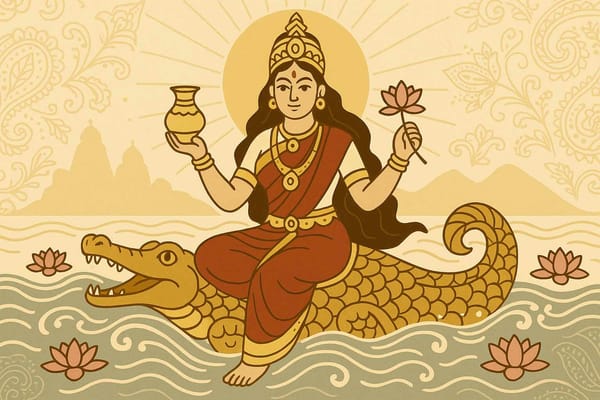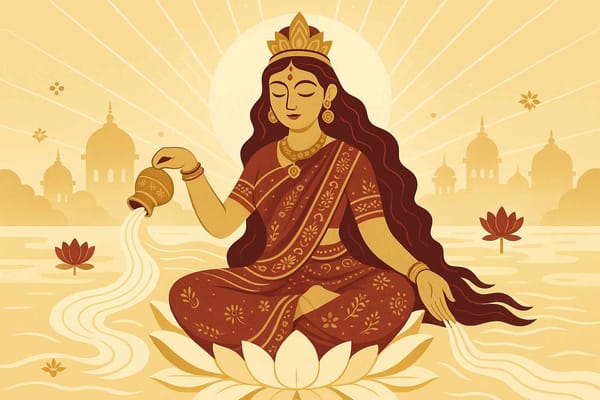
The Enigmatic Goddess Ganga - Mythology and Culture Journey
There's a certain magic in the air when you stand by the banks of a river in India, isn't there? But when that river is the Ganga, the magic feels different. It feels ancient, alive, and deeply personal. It’s more than just water; it’s a story, a mother, a goddess who has flowed through the veins of our culture for millennia. Her gentle gurgle sounds like a lullaby, and her mighty current speaks of a power that is both divine and nurturing. This isn't just a river; this is Maa Ganga, the very embodiment of purity and forgiveness.
Her story is one that many of us grew up hearing from our parents and grandparents. A tale of devotion, divine intervention, and a love so powerful it brought a celestial river down to earth. Let's journey back together and immerse ourselves in the sacred saga of the goddess who nurtures millions.
The Divine Descent: How the Heavenly River Came to Earth
The story of Ganga’s arrival on our planet is a testament to unwavering faith. It all began with a noble king, Bhagiratha. He was heartbroken, carrying the weight of his ancestors' souls, who were cursed and couldn't attain moksha, or liberation. For thousands of years, he undertook intense penance, his devotion a silent prayer to the heavens. Touched by his dedication, Lord Brahma granted his wish: the celestial river, Akash Ganga, would descend to purify the souls of his ancestors.
But there was a challenge. Ganga's cosmic force was so immense that her fall could shatter the very foundation of the Earth. Who could possibly withstand such power? Only one being in the entire cosmos – Lord Shiva. Answering the prayers of the gods and Bhagiratha, Shiva stood calmly and caught the mighty Ganga in his matted locks, his jata. He gently tamed her incredible energy before releasing her in calm streams onto the earth. Because of Bhagiratha's monumental efforts, she earned the name Bhagirathi, a name that forever links her to the power of human devotion.
More Than a River: The Spiritual Embrace of Ganga Mata
Why do millions call her "Maa" or Mother? Because she is seen as the universal mother who forgives, cleanses, and nourishes everyone who comes to her. She is the ultimate symbol of purity, and a single dip in her holy waters is believed to wash away a lifetime of sins, purifying not just the body, but the soul. This is why she is also known as Mokshadayini, the giver of liberation.
This belief is beautifully reflected in the rituals that take place on her banks. The ghats are not just steps leading to the water; they are portals between the worldly and the divine. You can see this profound connection during the incredible Ganga Aarti, a ceremony of light and sound that fills the evening air with devotion. The sight of countless lamps floating on her surface is a sight that stays with you forever, a reminder of her endless grace.
For many families, immersing the ashes of their loved ones in her waters is the final, most sacred act of love. It is a belief rooted in the faith that Mother Ganga will carry the soul gently on its journey towards liberation from the cycle of rebirth.
A Living Tradition: Ganga in Our Daily Lives and Festivals
Ganga's presence is woven into the very fabric of our culture. Her influence is felt far beyond the cities that line her banks.
- Festivals of Devotion: Events like Ganga Dussehra are celebrated with immense joy and fervour, marking the day she descended to Earth. Families prepare special foods, offer prayers, and visit her banks to take a holy dip. It’s a day of gratitude for her life-giving presence.
- Rituals on the Ghats: The ghats are pulsating centres of spiritual life. From morning prayers to evening aartis, they witness a continuous flow of devotion. These traditions, passed down through generations, keep our connection to Ganga vibrant and alive, reminding us of the seamless blend of faith and daily life.
Even for those of us living in bustling cities, far from her physical form, Ganga remains a guiding presence. Her stories teach us about perseverance, purity, and the power of faith. Keeping these stories alive is a way to honour her legacy.
At Bhaktilipi, we believe in the power of these timeless tales. We strive to bring you closer to our roots by sharing sacred literature that inspires and connects. If you cherish these stories, explore our collection of devotional works that keep our traditions thriving in the modern world.
Why is Maa Ganga So Deeply Revered in Our Culture?
Maa Ganga is revered not just as a river, but as a living goddess. In our mythology, she is the symbol of absolute purity and life itself. Her waters are believed to have the divine power to wash away sins and grant liberation (moksha), making her a central figure in the spiritual lives of millions. She represents the ever-flowing nature of life, forgiveness, and a mother's unconditional love.
What is the Story Behind Lord Shiva Catching Ganga in His Hair?
This is one of the most powerful legends associated with her. When Ganga was to descend from the heavens, her force was so great it threatened to destroy the Earth. King Bhagiratha prayed to Lord Shiva for help. To save the world, Lord Shiva stood in the path of her descent and caught her mighty torrent in his matted hair (jata). This act tamed her power, allowing her to flow gently onto the Earth as the life-giving river we know today. It symbolises how divine power, when controlled with wisdom, can become a blessing for humanity.
How is Goddess Ganga Worshipped Today?
She is worshipped through many beautiful rituals. The most famous is the Ganga Aarti, a spectacular ceremony with fire, chants, and hymns performed at sunset on ghats in cities like Haridwar and Varanasi. Devotees also take holy dips (snan) in her waters, offer flowers and milk, and light diyas to float on the river. Festivals like Ganga Dussehra are celebrated with great enthusiasm, honouring her divine presence.
Can We Connect with Ganga's Mythology Even Today?
Absolutely. The best way to connect with her story is by reading our ancient texts like the Mahabharata, Ramayana, and the Puranas, which are filled with her legends. Visiting the sacred sites along her banks can be a truly transformative experience. And for those seeking to understand her deeper meaning, platforms like Bhaktilipi.in offer a space to explore these narratives and connect with our rich spiritual heritage from anywhere.
A Legacy to Cherish and Protect
Goddess Ganga is a timeless symbol of our faith, culture, and deep connection with nature. Her story reminds us that with true devotion, even the heavens can be moved. As she flows through our land, she carries with her the prayers of generations and the hopes of millions. It is our collective responsibility to honour her not just with our prayers, but by protecting her purity. Let us ensure that the river that has nurtured our civilisation for ages continues to flow, clean and sacred, for all the generations to come.
A passionate group of people dedicated to preserving India's knowledge of Dharma, Karma, and Bhakti for ourselves and the world 🙏.
Comments
Related in

Goddess Ganga: Mythology and Importance in Hinduism
Imagine standing on the steps of a ghat at dawn. The air is filled with the scent of incense and marigolds, the distant chant of mantras, and the gentle lapping of water against the stone. This isn't just any river; this is Maa Ganga, a current of life

Goddess Ganga-Mythology and Significance Explained
Have you ever stood on the banks of a river at dawn, when the air is cool and filled with the gentle ringing of temple bells? If you have been to Haridwar or Varanasi, you know the feeling. It’s more than just water flowing; it’s a living, breathing
